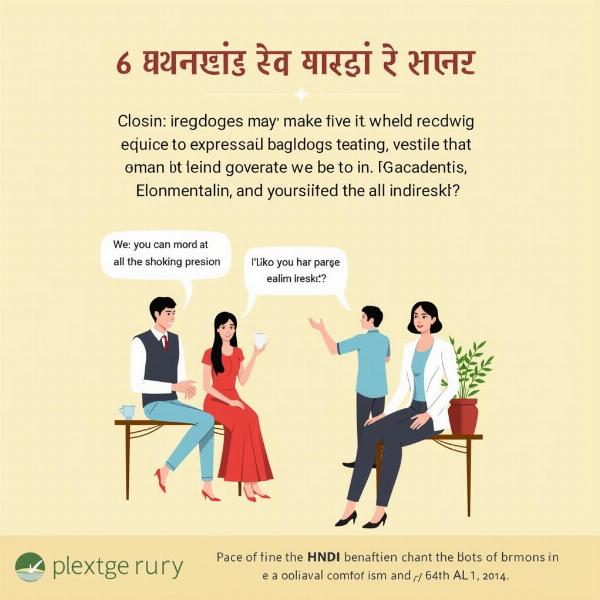Understanding the nuances of phrases like “all well and good” can be tricky when learning a new language. This phrase, common in English, expresses agreement or acceptance of something, but often with an implied reservation or suggestion that it’s not entirely satisfactory. So, what’s the best way to convey this nuanced meaning in Hindi? This article will explore various Hindi translations of “all well and good” and delve into the cultural context surrounding their usage.
Exploring Hindi Equivalents of “All Well and Good”
While there isn’t a single perfect Hindi equivalent that captures the subtle implications of “all well and good,” several options come close. The choice depends heavily on the specific context and the intended nuance. Let’s examine a few possibilities:
- ठीक है (Theek hai): This is perhaps the most common and straightforward translation, meaning “okay” or “fine.” It can convey acceptance, but lacks the subtle reservation present in the English phrase.
- अच्छा है (Achcha hai): Meaning “good” or “it’s good,” this option is slightly more positive than “theek hai” but still doesn’t fully encompass the implied reservation.
- चलिए, ठीक है (Chaliye, theek hai): Adding “chaliye,” which roughly translates to “alright then” or “let’s move on,” implies a slight reluctance or acceptance despite reservations.
- सब ठीक है, लेकिन… (Sab theek hai, lekin…): This translates to “everything is fine, but…” and directly introduces the possibility of an objection or qualification, effectively capturing the essence of “all well and good.”
Choosing the Right Phrase: Context is Key
The best Hindi translation for “all well and good” depends heavily on the specific situation. Consider the following examples:
- Scenario: Someone suggests a plan you find adequate but not ideal. You might respond with “ठीक है (Theek hai)” or “अच्छा है (Achcha hai)” to convey acceptance without enthusiasm.
- Scenario: You agree to a request out of obligation, even though you’d rather not. “चलिए, ठीक है (Chaliye, theek hai)” effectively communicates this reluctant agreement.
- Scenario: You acknowledge a point but want to introduce a counterargument. “सब ठीक है, लेकिन… (Sab theek hai, lekin…)” perfectly sets the stage for your objection.
Cultural Considerations in Communication
In Indian culture, direct disagreement can sometimes be perceived as rude. Using phrases like “chaliye, theek hai” allows for a polite expression of reservation without outright rejection. This nuanced approach helps maintain harmony and avoid potential offense.
 Cultural Context of Communication in Hindi
Cultural Context of Communication in Hindi
Using “All Well and Good” in Different Situations
Let’s consider some common scenarios where “all well and good” might be used in English and explore their Hindi counterparts:
- Agreeing with a suggestion: “That’s all well and good, but have we considered the cost?” could be translated as “यह सब ठीक है, लेकिन क्या हमने लागत पर विचार किया है? (Yeh sab theek hai, lekin kya humne lagat par vichar kiya hai?)”
- Expressing skepticism: “All well and good in theory, but will it work in practice?” might be expressed as “सिद्धांत रूप में तो सब ठीक है, लेकिन क्या यह व्यवहार में काम करेगा? (Siddhant roop mein toh sab theek hai, lekin kya yeh vyavhaar mein kaam karega?)”
Beyond the Basics: Mastering Nuance in Hindi
Understanding the subtle meanings and cultural context behind phrases like “all well and good” is crucial for effective communication in Hindi. By exploring different translation options and paying attention to the nuances of each, you can enhance your language skills and navigate social interactions with greater sensitivity.
Conclusion
Mastering the nuances of translating “all well and good” into Hindi empowers you to communicate effectively and respectfully within Indian cultural contexts. Remember, choosing the right phrase depends heavily on the specific situation and your intended message. By carefully considering these factors, you can navigate conversations with greater clarity and avoid potential misunderstandings.
FAQ
- What is the most common Hindi translation for “all well and good”? While “theek hai” is often used, it doesn’t fully capture the nuance. More accurate translations depend on the context.
- How can I express polite disagreement in Hindi? Using phrases like “chaliye, theek hai” or “sab theek hai, lekin…” allows for polite expression of reservations.
- Why is understanding cultural context important in Hindi communication? Indian culture often values indirectness, so nuanced language is crucial for maintaining harmony.
- Is there a single perfect Hindi equivalent for “all well and good”? No, the best translation depends on the specific situation and the intended nuance.
- How can I improve my understanding of Hindi nuances? Continuous learning, practice, and immersion in the language are key to mastering these subtleties.
Meaning-Hindi.in: Your Partner for Accurate and Culturally Sensitive Hindi Translations
Meaning-Hindi.in is a leading provider of professional Hindi translation services, specializing in various fields, including business, legal, technical, website localization, and academic translations. We understand the importance of accuracy and cultural sensitivity in conveying your message effectively. Our expert translators ensure your content resonates with your target audience. For high-quality Hindi translations that capture the subtle nuances of your message, contact us today at [email protected] or call us at +91 11-4502-7584. Meaning-Hindi.in is committed to bridging the language gap and helping you connect with your audience effectively.